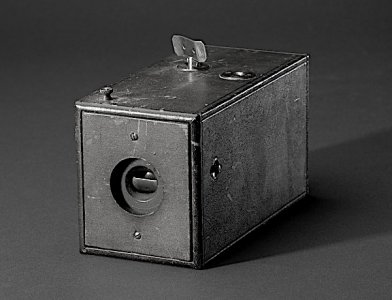Jason Schneider
the Camera Collector
Camera Collecting, The Incurable Passion, Part 2: Tales of Regret
Great vintage cameras I never bought, and others I foolishly sold.
By Jason Schneider
I’ve shelled out far too much cash collecting film cameras over the past 60 years or so to qualify as a cheapskate. However, I do have a distinct aversion to paying full price for anything, including vintage cameras, and I’ve been known to drive such a hard bargain that I’ve missed out on many photographic objects of my desire. To put that in perspective, it takes no talent to acquire a near mint chrome Nikon SP with 50mm f/1.4 Nikkor-S.C lens for the going price of around a grand, but if I could snag one for half that amount, I’d happily pull the trigger. Result: I’ve never managed to acquire a Nikon SP (or a Nikon S3 or S4 for that matter) even though I’ve always wanted one. I’ve had to content myself with a clean, functional (and amazingly heavy) Nikon S with near mint 50mm f/1.4 Nikkor I bought for a little over 100 bucks, and my favorite rangefinder Nikon, a flawless Nikon S2 body with original case I copped for $175 plus $10 shipping. Both are superb fun picture takers.
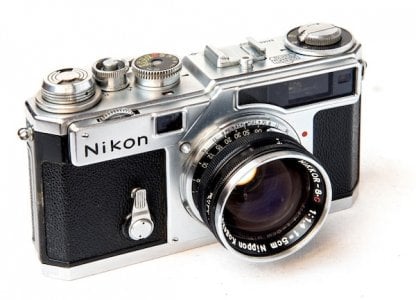
Nikon SP of with 50mm f/1.4 Nikkor-S.C: I've long lusted after this superb camera, but so far I haven't found one at a price I'm willing to pay.
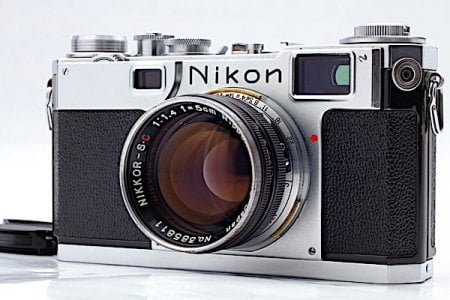
The glorious Nikon S2 with 50mm f/1.4 Nikkor-S.C: Elegant and spartan it has a large bright finder and is my favorite rangefinder Nikon.
Remaining in the domain of elite rangefinder 35s, I have all the Contaxes and Leicas I’ve ever wanted (except for the rare and extravagantly priced original Leica MP of the ‘50s) but there are a couple of rangefinder Canons I’ve always yearned for but never acquired because the price was too high. The first is the last of the breed, the Canon 7sZ that went out of production in 1968. Basically, it’s a Canon 7S with an upgraded range/viewfinder and a larger rewind crank and only 4,000 were made. Bodies run about $400-$500 a pop,
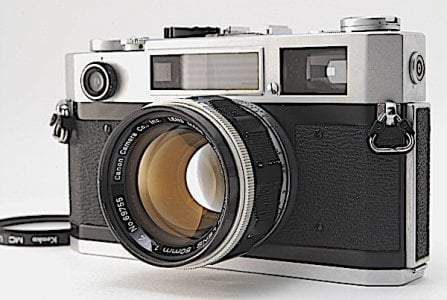
Canon 7sZ with 50mm f/1.4 Canon lens: The last if the breed, it bit the dust in 1968 and commands high prices. Only 4,000 were made.
nearly twice as much as I paid for my last Canon 7S, which came with a 50mm f/1.8 Canon lens and case! The second Canon I’ve always lusted after is the early postwar Canon S-II of 1946-1949, the only screw-mount Canon with a non-adjustable range/viewfinder, that was engraved Made in Occupied Japan and often came with a collapsible Elmar-inspired 50mm f/3.5 Serenar lens, an excellent Tessar design. These babies currently fetch about $1,500 a pop in near mint condition with lens, so I guess I’m out of luck.
Folding roll film rangefinder cameras is another vintage camera category that has always rung my chimes. I have about 25 of these critters in my motley collection but there are a few I’ve never managed to acquire, mainly because I just couldn’t justify the price.
My all-time favorite is the Konica Pearl IV of 1958, last of a long line of Konica (Konishiroku) Pearl folding cameras going back to 1909, and the last of the 6 x 4.5cm rangefinder series. It features an entirely new diecast aluminum body, an advanced range/viewfinder with a stationary projected frame line and parallax compensation markings (but no automatic parallax compensation) and a semi-automatic frame counter that provides double exposure prevention and an auto-stop mechanism once you manually align the start marks on the paper backing. The lens is a superb 4-element 75mm f/3.5 Hexar in a Seikosha-MXL shutter that provides speeds from 1-1/500 sec plus B, a self-timer, and MFX sync via a standard PC socket. I have shot with a Konica Pearl IV and can confirm that it performs splendidly as well as being drop dead gorgeous, but it sells in the $400-$550 range (up to around $800 for mint examples with case), which is why I’ll probably never acquire one.
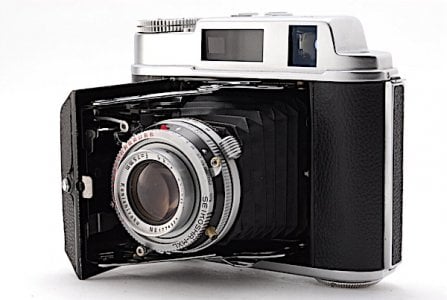
Konica Pearl IV of 1958 was last and best of the 4.5 x 6cm Konica Pearl series thanks to its superb range/viewfinder with projected frame line.
The Voigtlander Bessa II is the postwar version of the prewar Rangefinder Bessa, a 6 x 9cm folding camera with a coupled rangefinder, a separate viewfinder eyepiece, a unit-focusing lens (unlike the Zeiss Super Ikontas that feature front cell focusing lenses), and a rather delicate front standard. To this mix the Bessa II added a coupled, single eyepiece range/viewfinder, coated lenses in Synchro-Compur 1-1/500 sec plus B shutters (early versions had Compur-Rapid 1/400 sec shutters), and chrome finished bodies. My beautiful black near-mint Rangefinder Bessa has an uncoated 10.5cm f/3.5 Heliar lens in a 1-1/400 sec plus B and T Compur-Rapid shutter. My lovely chrome finished Bessa II has a coated 10.5cm f/3.5 Color-Skopar lens in a Synchro-Compur 1-1/500 sec plus B shutter. According to Camera-Wiki, 34,500 Bessa IIs were made from 1950 to 1956. They were fitted with a Color-Skopar 3.5/10.5cm, a Color-Heliar 3.5/10.5cm, or, from 1954, the rare and much-sought-after Apo-Lanthar 4.5/10.5cm lens said to be an apochromat optimized for color photography. I’ve hankered to acquire a Voigtlender Bessa II with an Apo-Lanthar lens for most if my adult life, but I’ve never found one at a price I’m willing to pay. As of this writing there are 2 examples listed on eBay, a mint one at $15,300 or best offer and a very clean one at $6,495.00, Buy It Now plus $95.00 shipping. They’re all great shooters with dinky viewfinder, but not as robust as Super Ikontas, so if you take the plunge, handle yours with care.
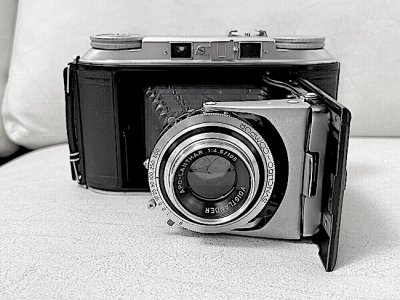
Voigtlander Bessa II with coveted105mm f/4.5 Apo-Lanthar lens is a collector's prize but far too pricey, so I settle for one with a Color-Skopar.
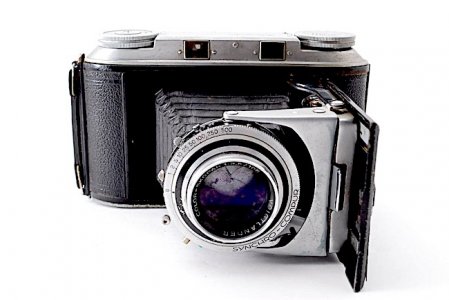
Here's my trusty Bessa II with 105mm f/3.5 Color-Skopar lens. It's a superb picture taker but it's not as robust as a Super-Ikonta so be gentle.
The Ernemann Miniatur-Klapp camera, a strut-type folding camera, was introduced as a second alternative version of the legendary solid bodied Ermanox, the 4.5 x 6 cm plate camera with super-speed lenses made by Ernemann of Dresden starting in 1924. The Ermaniox, made famous by the stealthy unposed photos of diplomats captured by Dr. Erich Salomon, had a huge and unusually fast 85 mm f/1.8 or 100 mm f/2 Ernostar lens and a focal-plane shutter, with speeds of 1/20 - 1/1000 second, plus 'B' and 'T'. The Miniatur-Klapp (it means “miniature folding” in German) took the same size plates as the Ermaniox and had the same old fashioned cloth focal-plane shutter with separate settings for slit width and spring tension, but it was fitted with a more modest 75mm f/4.5 Ernostar lens, which made it a lot more portable and better balanced. Since an Ermanox with original fast lens in working order goes for about $4,000-$6,000 I was hoping to acquire an Ernemann Miniatur-Klapp camera for a lot less, but $450.00 was the lowest price I’ve ever found for an allegedly “working” example, but the seller didn’t offer return privileges, so I gave it a pass. Why? Repairing a shutter on one of these beasts (if you can even find someone brave and skilled enough to attempt it) can easily run a few hundred bucks.
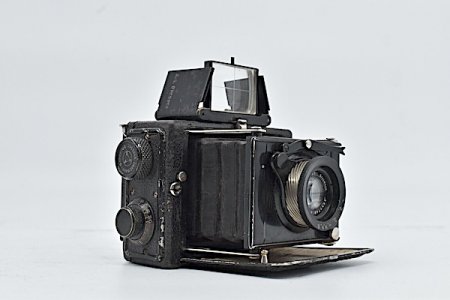
Ernemann Miniatur-Klapp 4.5 x 6 cm plate camera of the '20s is handier than an Ermanox, but I haven't found one at a price I'm willing to pay.
Another camera I’ve longed to own but never acquired is the Bronica D (for Deluxe), the second, slightly more reliable iteration of the original notoriously troublesome Bronica Z of 1959, which had shutter speeds up to 1/1250 sec, interchangeable first frame positioning magazines, and a gorgeous two-tone (light and dark gray) finish. The “improved” Bronica D uses different film magazines that require manual first frame positioning, is said to incorporate mechanics tweaked for better reliability, and retains the natty two-tine finish of its predecessor. I’ve been searching for a clean working Bronica D for years and I’ve never found a suitable one for less than a grand from a seller that accepts returns. I’m still looking.
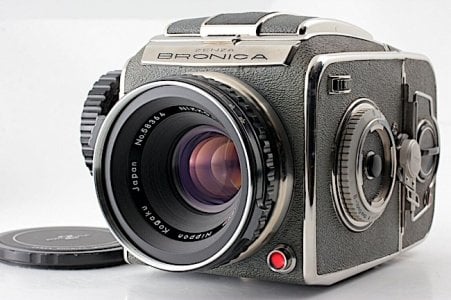
The Bronica D (Deluxe) of 1960 is a lightly tweaked version of the original Bronica Z and just as pretty, but a but too pricey. I'm still looking.
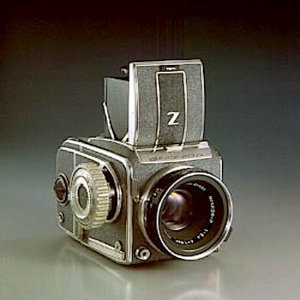
Here's the original Bronica Z of 1959, the holy grail of Bronica collectors. I had one and used it with satisfaction but sold it for a good cause.
Misadventures with the legendary Bronica Z
The supreme irony is that I had already owned a compete 4-lens Bronica Z outfit in its original fitted brown leather case. It had been passed down to my longtime friend by his well-heeled MD dad, and soon afterward, my buddy was desperately seeking a Nikon F but had insufficient funds. So, he proposed trading the Bronica Z outfit to me straight across for my lightly used Nikon FTn with 50mm f/1.4 Nikkor, which I did, And in the ensuing 6 -9 months, I gently and respectfully ran about 100 rolls through the Bronica Z without experiencing any problems whatsoever. Then I reluctantly sold the whole shebang at a bargain price to another friend who’d gotten his first upscale professional assignment and needed to show up with a medium format SLR. The next time I saw the Bronica Z was at his Greenwich Village studio where he was shooting a portfolio of a beautiful young female model under hot lights. After he took the first shot, he calmly walked back to the tripod-mounted Bronica and gave it a fearsome whack with the open palm of his right hand. “What the hell are you doing, Mike,” I shouted. “Oh, it’s been that way for a long time,” he explained. “I’ve got to do that after each shot, or the mirror won’t return.” Moral: The advanced, feature-laden Bronica Z may not have been the most reliable 6 x 6cm SLR ever made, but at least some of its issues are attributable to the tender mercies of ham-fisted photographers like Mike.
Four great cameras and one rare and superlative lens I foolishly sold.
In my 65+ years as a “collector of things” I’ve mostly concentrated on cameras, but I’ve always been fascinated by “mechanical things that work” and have accumulated smaller de facto collections of pocket watches, wristwatches, fountain pens, binoculars, and motorcycles. My late great mother collected wall and mantle clocks, and my paternal grandfather left us an extensive and variegated collection of “interesting things,” so I guess the apple falleth not too far from the tree. Indeed, I’ve mused about compiling a book entitled “Things I Foolishly Sold, by Jason Schneider” and I’m confident I could fill 500 pages with regrets. But for mow here’s a short excerpt covering 4 cameras, and one lens that still gives me a lump in the throat when I think about them.
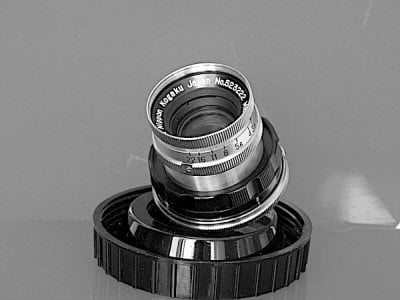
The rare and legendary 50mm f/3.5 Micro-NIKKOR of 1956 in Leica screw mount. I still kick myself for selling mine for a paltry profit in '75.
The collapsible 50mm f/3.5 Micro Nikkor of 1956 was Nikon’s first Micro lens and one of the rarest rangefinder lenses Nikon ever made. All were finished in chrome and the total production came to 1,188 lenses, 901 in Nikon S bayonet mount (marked Micro-NIKKOR C) and a mere 287 in Leica screw mount. Since I didn’t own a rangefinder Nikon when I bought it back in 1972 for the grand sum of $138.00, mine was the ultra-rare Leica screw mount version. Both types are rangefinder coupled down to 3 feet in extended position, and it can be focused manually within from 1.5 to 3 feet when collapsed, using a ruler and the separate close-focusing scale, and possibly the rare Nikon Rangefinder copying stand. Since the aperture ring is inaccessible with the lens collapsed, Nikon made a special collar that lets you set the f/stop when the lens is used on a copy stand.
At the time if its production the 5-element, 4-group 50mm f/3.5 Micro-Nikkor provided higher resolution than any other lens in the Nikon rangefinder line and it offered an extraordinary level of color correction too (Modern Photography called it an apochromat). It has click-stopped aperture settings down to f/22, a 7-bladed diaphragm to enhance its smooth, natural bokeh, and it weighs in at 4.8 ounces. Not surprisingly Nikon used the same optical formula 4 years later when they bought forth the acclaimed 55mm f/3.5 Micro-Nikkor in F-mount.
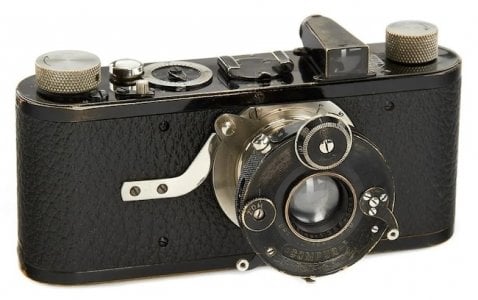
Leica B of the late '20s with 50mm f/3.5 Elmar in dial-set Compur shutter. Mine had a Hektor lens, a combo that shouldn't exist, but I never took its picture before selling it to a collector friend at what I thought was a handsome profit. You can read the whole sad story below.
I thought I was making a killing when I sold my beautiful 50mm f/3.5 Micro-Nikkor to a Nikon collector for $400 back in 1975, but it was anything but. As of this writing there are 2 of these beauties listed on eBay, one at $6,000, the other at $7,800! Even the more plentiful Nikon S bayonet mount versions go for $2000-$2500.
My almost mythical Leica B
Sometime in 1970 I acquired a Leica B, the rangefinder-less model normally fitted with a non-interchangeable, collapsible 50mm f/3.5 Elmar lens mounted in a Compur 1-1/300 sec plus T and B leaf shutter (the dial set shutter Compur from 1926-1929, and rim-set version from 1930 until the last few B’s were turned out in 1941. The Leica B was a low-production model, with only 638 dial-set shutter and 1,072 rim-set shutter units produced. It was designed primarily for scientists and researchers that needed a camera providing shutter speeds below 1/20 sec prior to the introduction of the Leica III (Model F) of 1933, the first focal plane shutter Leica with a slow-speed dial.
Well, it turns out the Leica B I purchased for $160 was very special—so special it shouldn’t even exist! That’s because it was fitted with a 50mm f/2.5 Hektor lens in a dial-set Compur shutter, an option never offered by the factory or described in any delivery records. Now lest you assume that some devilishly clever tinkerer simply swapped out the lens elements of the Hektor and mounted them in the existing Compur shutter (which, by itself, would be no mean undertaking), think again. Since the diameter of the Hekor lens is substantially larger than the Elmar’s it requires a larger diameter Compur shutter as well. Not to mention the fact that my Leica B came in a special tall Leica engraved leather case with space to accommodate the included Leitz FODIS rangefinder when mounted horizontally in the accessory shoe!
According to Leica guru James Lager my “Leica B Hektor” was most likely a one-off created by a very talented machinist or a moonlighting Leica technician, either for him/her-self or at the behest of a wealthy client. I eventually sold it in around 1976 to a noted New York collector who badgered me for the best part of a year before I let it go for $3,500 (I really needed the money at the time). Although he is long deceased and his collection has been liquidated, I must still honor my pledge never to reveal his identity. What rankles me the most is not that I sold this extraordinary camera, but that I never took photos of it or featured it in one if my columns. I certainly should have done both.
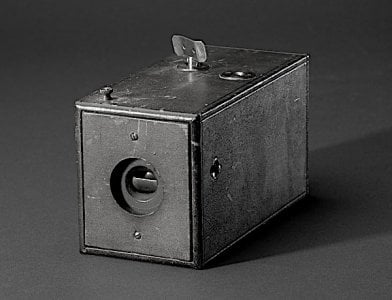
The Kodak of 1888: George Eastman's masterpiece was a point-and shoot that transformed photography, and I bought one for a song, but...
The original Kodak of 1888. The Kodak, the first camera marketed by the Eastman Dry Plate & Film Co. of Rochester, New York, may well be the most historically important series-production camera ever made. I bought one of these humble looking masterpieces back in 1997, when it was listed on eBay as an “old Eastman Kodak box camera” at “$22.00 or best offer.” I snapped it up at the asking price because I knew exactly what it was—and that even back then it was worth well over a grand.
What the Kodak offered in 1888 for the then-handsome sum of $25, was an unintimidating, easy-to use “point and shoot” camera with no adjustments that was pre-loaded with roll film sufficient for 100 exposures. When you were finished shooting the roll, you shipped the camera back to Eastman in Rochester, along with $10, making The Kodak the camera that created the modern photofinishing industry.
Described as “about the size of a large field glass” it measures 3-1/4 x 3-1/4 x 6-1/2 inches and weighs 1lb. 10 oz. It produced circular pictures 2-1/2 inches in diameter on 2-3/4-inch-wide flexible roll film, had no frame counter (you had to count the number of turns when winding the film-advance key!) and no viewfinder—you aimed it with the aid of two lines, in a V pattern, engraved into the top. The lens, contained in a unique barrel-type shutter that revolved on an axis parallel to the film plane, was a 57mm f/9 Rapid Rectilinear. Based on the format it was a wide-angle, which gave good depth of field, but image quality in the corners of the field would have been poor, so the “corner-less” circular format made sense technically. The shutter, which was manually cocked with a pull cord. provided a single shutter speed of about 1/25 sec, and a felt plug, which fitted on the front of the camera, could be used for making time exposures. The shutter-release button was on the left, a tripod socket oddly placed on the top-- but with no viewfinder this hardly mattered! Despite its spartan simplicity, ample price, and the inconvenience of having to return the camera for processing, the Kodak was a phenomenal success because it was the first camera that enabled anyone to take pictures, and it was aggressively marketed with a brilliant advertising campaign.
Eastman’s astute grasp of human psychology and motivation is evident in these quotes from an1888 Kodak ad: “Anybody who can wind a watch can use the Kodak Camera…No tripod, no focusing, no adjustment whatever…A picturesque diary of your trip…may be obtained without trouble that will be worth a hundred times its cost in after years.” In 1889, it was “1. Pull the cord 2. Turn the key 3. Press the button. And so on for 100 pictures.” This was later refined into the greatest photographic advertising slogan of all time, “You press the button, we do the rest.” An original Kodak Camera, one of the holy grails of camera collecting, now verges on being a museum piece. Early barrel-shutter models in good condition sell in the $4000-5000 range: pristine and complete example with case and instruction manual could easily fetch much more. Later models with “safety-pin” metal-bladed shutter are worth less but are still scarce and collectible. Now you know why I’m bummed that I let my near-mint example go for a paltry $1,800 back in 2022. Oh well, at least it went to a serious Kodak collector.
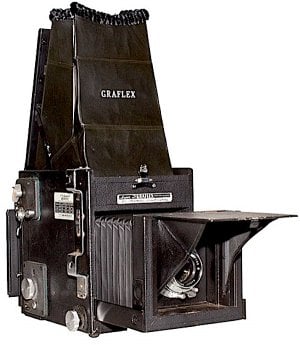
Super D Graflex: A higher-tech version of a camera dating back to 1902, I bought one at a bargain price and let it go for peanuts.
Super D Graflex. Introduced in 1941, the Super D was the ultimate large-format single-lens reflex camera in terms of technical features. I bought my near mint example in the mid ‘70s for a paltry $135 at a Baltimore pawn shop, complete with an excellent coated 190mm f/5.6 Graflex Optar lens that had a manually cocked semi-auto diaphragm. I took many satisfying portraits with it, foolishly sold it about 5 years later for under 200 bucks, and I’ve regretted it ever since. Offered in 4x5- and 3-/4x4-1/4-inch versions, the Super D Graflexs had a front-surface mirror and Ektalite field lens for brighter viewing, a revolving Graflok back, built-in flash sync, and a great hulking cloth focal plane shutter with speeds from 1/30 to 1/1000 sec. Like all Graflex SLRs going back to 1902, my long-lost Super D had separate settings for spring tension and slit width to determine the shutter speed, waist level viewing via a tall focusing hood, and heavy, rugged construction. This majestic camera is still capable of formidable performance, but it’s more of a collector’s item these days. The more desirable 4 x 5 version in good nick currently runs about $1,200 to $1,500 so I’m not likely to spring for another anytime soon. Boo-hoo.
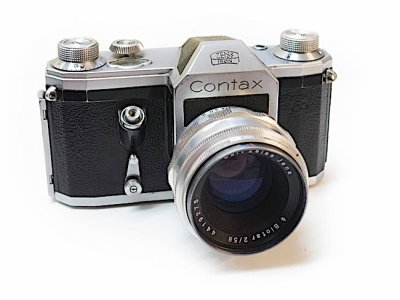
Contax S made by VEB Zeiss-Ikon was the first widely distributed 35mm SLR with a pentaprism, and pretty too. I traded mine in for a pittance.
Contax S. Introduced in 1949, the Contax S was the first widely distributed 35mm SLR with an eye-level pentaprism providing laterally correct, right-side-up viewing and focusing. Attracted by its elegant proportions, spartan simplicity, and outstanding coated 58mm f/2 Zeiss Biotar pre-set lens, I snagged a mint one for 90 bucks from a private seller in the late ‘70s, and then flogged it for roughly the same amount to a camera store a few years later as part of a trade-in deal on a Hasseblad 500C. I still have the Hasselblad, but I sure miss my beautiful Contax S that now fetches about $500-$700 in pristine, fully functional condition with the same lens, and is hard to find even at those prices.
The Contax S, a product of VEB Zeiss-Ikon (aka East German Zeiss), was also the first to embody the classic modern SLR shape adopted by virtually all other manufacturers. The Italian Rectaflex and Swiss Alpa Prisma Reflex III, both pentaprism 35mm SLRs introduced in the same year, were of very distinctive design and produced in limited quantities. The general configuration of the Contax S, and its M-42 screw mount, had a profound influence on SLR design for well over 20 years. Examples include various Rolleis, Voigtlanders, Edixas, and Zeiss-Ikon Icarexes from Germany, and Japanese SLRs of the 60s and 70s, including Pentax, Fuji, Yashica, Ricoh, Chinon, Cosina, and the short-lived Olympus FTL. The Contax S features a cloth focal-plane shutter with speeds from 1 to-1/1000 sec plus B set via a single, rotating, top-mounted dial with speed readouts under a small glass window, knob wind and rewind, a 45-degree angled shutter release, flash sync connection in tripod socket, hinged back and self-timer. It lacks an instant-return mirror and an automatic lens diaphragm—later models feature semi-automatic diaphragm operation via an internal stop-down plate in the body. Models labeled Contax and bearing the Zeiss-Ikon logo are not too common. Later models labeled Pentacon or Hexacon with C.Z. or other lens designations are less desirable and sell in the $150-$300 range. Good hunting! May you all find the vintage cameras of your dreams at affordable prices, and then hang onto them for dear life!
Great vintage cameras I never bought, and others I foolishly sold.
By Jason Schneider
I’ve shelled out far too much cash collecting film cameras over the past 60 years or so to qualify as a cheapskate. However, I do have a distinct aversion to paying full price for anything, including vintage cameras, and I’ve been known to drive such a hard bargain that I’ve missed out on many photographic objects of my desire. To put that in perspective, it takes no talent to acquire a near mint chrome Nikon SP with 50mm f/1.4 Nikkor-S.C lens for the going price of around a grand, but if I could snag one for half that amount, I’d happily pull the trigger. Result: I’ve never managed to acquire a Nikon SP (or a Nikon S3 or S4 for that matter) even though I’ve always wanted one. I’ve had to content myself with a clean, functional (and amazingly heavy) Nikon S with near mint 50mm f/1.4 Nikkor I bought for a little over 100 bucks, and my favorite rangefinder Nikon, a flawless Nikon S2 body with original case I copped for $175 plus $10 shipping. Both are superb fun picture takers.

Nikon SP of with 50mm f/1.4 Nikkor-S.C: I've long lusted after this superb camera, but so far I haven't found one at a price I'm willing to pay.

The glorious Nikon S2 with 50mm f/1.4 Nikkor-S.C: Elegant and spartan it has a large bright finder and is my favorite rangefinder Nikon.
Remaining in the domain of elite rangefinder 35s, I have all the Contaxes and Leicas I’ve ever wanted (except for the rare and extravagantly priced original Leica MP of the ‘50s) but there are a couple of rangefinder Canons I’ve always yearned for but never acquired because the price was too high. The first is the last of the breed, the Canon 7sZ that went out of production in 1968. Basically, it’s a Canon 7S with an upgraded range/viewfinder and a larger rewind crank and only 4,000 were made. Bodies run about $400-$500 a pop,

Canon 7sZ with 50mm f/1.4 Canon lens: The last if the breed, it bit the dust in 1968 and commands high prices. Only 4,000 were made.
nearly twice as much as I paid for my last Canon 7S, which came with a 50mm f/1.8 Canon lens and case! The second Canon I’ve always lusted after is the early postwar Canon S-II of 1946-1949, the only screw-mount Canon with a non-adjustable range/viewfinder, that was engraved Made in Occupied Japan and often came with a collapsible Elmar-inspired 50mm f/3.5 Serenar lens, an excellent Tessar design. These babies currently fetch about $1,500 a pop in near mint condition with lens, so I guess I’m out of luck.
Folding roll film rangefinder cameras is another vintage camera category that has always rung my chimes. I have about 25 of these critters in my motley collection but there are a few I’ve never managed to acquire, mainly because I just couldn’t justify the price.
My all-time favorite is the Konica Pearl IV of 1958, last of a long line of Konica (Konishiroku) Pearl folding cameras going back to 1909, and the last of the 6 x 4.5cm rangefinder series. It features an entirely new diecast aluminum body, an advanced range/viewfinder with a stationary projected frame line and parallax compensation markings (but no automatic parallax compensation) and a semi-automatic frame counter that provides double exposure prevention and an auto-stop mechanism once you manually align the start marks on the paper backing. The lens is a superb 4-element 75mm f/3.5 Hexar in a Seikosha-MXL shutter that provides speeds from 1-1/500 sec plus B, a self-timer, and MFX sync via a standard PC socket. I have shot with a Konica Pearl IV and can confirm that it performs splendidly as well as being drop dead gorgeous, but it sells in the $400-$550 range (up to around $800 for mint examples with case), which is why I’ll probably never acquire one.

Konica Pearl IV of 1958 was last and best of the 4.5 x 6cm Konica Pearl series thanks to its superb range/viewfinder with projected frame line.
The Voigtlander Bessa II is the postwar version of the prewar Rangefinder Bessa, a 6 x 9cm folding camera with a coupled rangefinder, a separate viewfinder eyepiece, a unit-focusing lens (unlike the Zeiss Super Ikontas that feature front cell focusing lenses), and a rather delicate front standard. To this mix the Bessa II added a coupled, single eyepiece range/viewfinder, coated lenses in Synchro-Compur 1-1/500 sec plus B shutters (early versions had Compur-Rapid 1/400 sec shutters), and chrome finished bodies. My beautiful black near-mint Rangefinder Bessa has an uncoated 10.5cm f/3.5 Heliar lens in a 1-1/400 sec plus B and T Compur-Rapid shutter. My lovely chrome finished Bessa II has a coated 10.5cm f/3.5 Color-Skopar lens in a Synchro-Compur 1-1/500 sec plus B shutter. According to Camera-Wiki, 34,500 Bessa IIs were made from 1950 to 1956. They were fitted with a Color-Skopar 3.5/10.5cm, a Color-Heliar 3.5/10.5cm, or, from 1954, the rare and much-sought-after Apo-Lanthar 4.5/10.5cm lens said to be an apochromat optimized for color photography. I’ve hankered to acquire a Voigtlender Bessa II with an Apo-Lanthar lens for most if my adult life, but I’ve never found one at a price I’m willing to pay. As of this writing there are 2 examples listed on eBay, a mint one at $15,300 or best offer and a very clean one at $6,495.00, Buy It Now plus $95.00 shipping. They’re all great shooters with dinky viewfinder, but not as robust as Super Ikontas, so if you take the plunge, handle yours with care.

Voigtlander Bessa II with coveted105mm f/4.5 Apo-Lanthar lens is a collector's prize but far too pricey, so I settle for one with a Color-Skopar.

Here's my trusty Bessa II with 105mm f/3.5 Color-Skopar lens. It's a superb picture taker but it's not as robust as a Super-Ikonta so be gentle.
The Ernemann Miniatur-Klapp camera, a strut-type folding camera, was introduced as a second alternative version of the legendary solid bodied Ermanox, the 4.5 x 6 cm plate camera with super-speed lenses made by Ernemann of Dresden starting in 1924. The Ermaniox, made famous by the stealthy unposed photos of diplomats captured by Dr. Erich Salomon, had a huge and unusually fast 85 mm f/1.8 or 100 mm f/2 Ernostar lens and a focal-plane shutter, with speeds of 1/20 - 1/1000 second, plus 'B' and 'T'. The Miniatur-Klapp (it means “miniature folding” in German) took the same size plates as the Ermaniox and had the same old fashioned cloth focal-plane shutter with separate settings for slit width and spring tension, but it was fitted with a more modest 75mm f/4.5 Ernostar lens, which made it a lot more portable and better balanced. Since an Ermanox with original fast lens in working order goes for about $4,000-$6,000 I was hoping to acquire an Ernemann Miniatur-Klapp camera for a lot less, but $450.00 was the lowest price I’ve ever found for an allegedly “working” example, but the seller didn’t offer return privileges, so I gave it a pass. Why? Repairing a shutter on one of these beasts (if you can even find someone brave and skilled enough to attempt it) can easily run a few hundred bucks.

Ernemann Miniatur-Klapp 4.5 x 6 cm plate camera of the '20s is handier than an Ermanox, but I haven't found one at a price I'm willing to pay.
Another camera I’ve longed to own but never acquired is the Bronica D (for Deluxe), the second, slightly more reliable iteration of the original notoriously troublesome Bronica Z of 1959, which had shutter speeds up to 1/1250 sec, interchangeable first frame positioning magazines, and a gorgeous two-tone (light and dark gray) finish. The “improved” Bronica D uses different film magazines that require manual first frame positioning, is said to incorporate mechanics tweaked for better reliability, and retains the natty two-tine finish of its predecessor. I’ve been searching for a clean working Bronica D for years and I’ve never found a suitable one for less than a grand from a seller that accepts returns. I’m still looking.

The Bronica D (Deluxe) of 1960 is a lightly tweaked version of the original Bronica Z and just as pretty, but a but too pricey. I'm still looking.

Here's the original Bronica Z of 1959, the holy grail of Bronica collectors. I had one and used it with satisfaction but sold it for a good cause.
Misadventures with the legendary Bronica Z
The supreme irony is that I had already owned a compete 4-lens Bronica Z outfit in its original fitted brown leather case. It had been passed down to my longtime friend by his well-heeled MD dad, and soon afterward, my buddy was desperately seeking a Nikon F but had insufficient funds. So, he proposed trading the Bronica Z outfit to me straight across for my lightly used Nikon FTn with 50mm f/1.4 Nikkor, which I did, And in the ensuing 6 -9 months, I gently and respectfully ran about 100 rolls through the Bronica Z without experiencing any problems whatsoever. Then I reluctantly sold the whole shebang at a bargain price to another friend who’d gotten his first upscale professional assignment and needed to show up with a medium format SLR. The next time I saw the Bronica Z was at his Greenwich Village studio where he was shooting a portfolio of a beautiful young female model under hot lights. After he took the first shot, he calmly walked back to the tripod-mounted Bronica and gave it a fearsome whack with the open palm of his right hand. “What the hell are you doing, Mike,” I shouted. “Oh, it’s been that way for a long time,” he explained. “I’ve got to do that after each shot, or the mirror won’t return.” Moral: The advanced, feature-laden Bronica Z may not have been the most reliable 6 x 6cm SLR ever made, but at least some of its issues are attributable to the tender mercies of ham-fisted photographers like Mike.
Four great cameras and one rare and superlative lens I foolishly sold.
In my 65+ years as a “collector of things” I’ve mostly concentrated on cameras, but I’ve always been fascinated by “mechanical things that work” and have accumulated smaller de facto collections of pocket watches, wristwatches, fountain pens, binoculars, and motorcycles. My late great mother collected wall and mantle clocks, and my paternal grandfather left us an extensive and variegated collection of “interesting things,” so I guess the apple falleth not too far from the tree. Indeed, I’ve mused about compiling a book entitled “Things I Foolishly Sold, by Jason Schneider” and I’m confident I could fill 500 pages with regrets. But for mow here’s a short excerpt covering 4 cameras, and one lens that still gives me a lump in the throat when I think about them.

The rare and legendary 50mm f/3.5 Micro-NIKKOR of 1956 in Leica screw mount. I still kick myself for selling mine for a paltry profit in '75.
The collapsible 50mm f/3.5 Micro Nikkor of 1956 was Nikon’s first Micro lens and one of the rarest rangefinder lenses Nikon ever made. All were finished in chrome and the total production came to 1,188 lenses, 901 in Nikon S bayonet mount (marked Micro-NIKKOR C) and a mere 287 in Leica screw mount. Since I didn’t own a rangefinder Nikon when I bought it back in 1972 for the grand sum of $138.00, mine was the ultra-rare Leica screw mount version. Both types are rangefinder coupled down to 3 feet in extended position, and it can be focused manually within from 1.5 to 3 feet when collapsed, using a ruler and the separate close-focusing scale, and possibly the rare Nikon Rangefinder copying stand. Since the aperture ring is inaccessible with the lens collapsed, Nikon made a special collar that lets you set the f/stop when the lens is used on a copy stand.
At the time if its production the 5-element, 4-group 50mm f/3.5 Micro-Nikkor provided higher resolution than any other lens in the Nikon rangefinder line and it offered an extraordinary level of color correction too (Modern Photography called it an apochromat). It has click-stopped aperture settings down to f/22, a 7-bladed diaphragm to enhance its smooth, natural bokeh, and it weighs in at 4.8 ounces. Not surprisingly Nikon used the same optical formula 4 years later when they bought forth the acclaimed 55mm f/3.5 Micro-Nikkor in F-mount.

Leica B of the late '20s with 50mm f/3.5 Elmar in dial-set Compur shutter. Mine had a Hektor lens, a combo that shouldn't exist, but I never took its picture before selling it to a collector friend at what I thought was a handsome profit. You can read the whole sad story below.
I thought I was making a killing when I sold my beautiful 50mm f/3.5 Micro-Nikkor to a Nikon collector for $400 back in 1975, but it was anything but. As of this writing there are 2 of these beauties listed on eBay, one at $6,000, the other at $7,800! Even the more plentiful Nikon S bayonet mount versions go for $2000-$2500.
My almost mythical Leica B
Sometime in 1970 I acquired a Leica B, the rangefinder-less model normally fitted with a non-interchangeable, collapsible 50mm f/3.5 Elmar lens mounted in a Compur 1-1/300 sec plus T and B leaf shutter (the dial set shutter Compur from 1926-1929, and rim-set version from 1930 until the last few B’s were turned out in 1941. The Leica B was a low-production model, with only 638 dial-set shutter and 1,072 rim-set shutter units produced. It was designed primarily for scientists and researchers that needed a camera providing shutter speeds below 1/20 sec prior to the introduction of the Leica III (Model F) of 1933, the first focal plane shutter Leica with a slow-speed dial.
Well, it turns out the Leica B I purchased for $160 was very special—so special it shouldn’t even exist! That’s because it was fitted with a 50mm f/2.5 Hektor lens in a dial-set Compur shutter, an option never offered by the factory or described in any delivery records. Now lest you assume that some devilishly clever tinkerer simply swapped out the lens elements of the Hektor and mounted them in the existing Compur shutter (which, by itself, would be no mean undertaking), think again. Since the diameter of the Hekor lens is substantially larger than the Elmar’s it requires a larger diameter Compur shutter as well. Not to mention the fact that my Leica B came in a special tall Leica engraved leather case with space to accommodate the included Leitz FODIS rangefinder when mounted horizontally in the accessory shoe!
According to Leica guru James Lager my “Leica B Hektor” was most likely a one-off created by a very talented machinist or a moonlighting Leica technician, either for him/her-self or at the behest of a wealthy client. I eventually sold it in around 1976 to a noted New York collector who badgered me for the best part of a year before I let it go for $3,500 (I really needed the money at the time). Although he is long deceased and his collection has been liquidated, I must still honor my pledge never to reveal his identity. What rankles me the most is not that I sold this extraordinary camera, but that I never took photos of it or featured it in one if my columns. I certainly should have done both.

The Kodak of 1888: George Eastman's masterpiece was a point-and shoot that transformed photography, and I bought one for a song, but...
The original Kodak of 1888. The Kodak, the first camera marketed by the Eastman Dry Plate & Film Co. of Rochester, New York, may well be the most historically important series-production camera ever made. I bought one of these humble looking masterpieces back in 1997, when it was listed on eBay as an “old Eastman Kodak box camera” at “$22.00 or best offer.” I snapped it up at the asking price because I knew exactly what it was—and that even back then it was worth well over a grand.
What the Kodak offered in 1888 for the then-handsome sum of $25, was an unintimidating, easy-to use “point and shoot” camera with no adjustments that was pre-loaded with roll film sufficient for 100 exposures. When you were finished shooting the roll, you shipped the camera back to Eastman in Rochester, along with $10, making The Kodak the camera that created the modern photofinishing industry.
Described as “about the size of a large field glass” it measures 3-1/4 x 3-1/4 x 6-1/2 inches and weighs 1lb. 10 oz. It produced circular pictures 2-1/2 inches in diameter on 2-3/4-inch-wide flexible roll film, had no frame counter (you had to count the number of turns when winding the film-advance key!) and no viewfinder—you aimed it with the aid of two lines, in a V pattern, engraved into the top. The lens, contained in a unique barrel-type shutter that revolved on an axis parallel to the film plane, was a 57mm f/9 Rapid Rectilinear. Based on the format it was a wide-angle, which gave good depth of field, but image quality in the corners of the field would have been poor, so the “corner-less” circular format made sense technically. The shutter, which was manually cocked with a pull cord. provided a single shutter speed of about 1/25 sec, and a felt plug, which fitted on the front of the camera, could be used for making time exposures. The shutter-release button was on the left, a tripod socket oddly placed on the top-- but with no viewfinder this hardly mattered! Despite its spartan simplicity, ample price, and the inconvenience of having to return the camera for processing, the Kodak was a phenomenal success because it was the first camera that enabled anyone to take pictures, and it was aggressively marketed with a brilliant advertising campaign.
Eastman’s astute grasp of human psychology and motivation is evident in these quotes from an1888 Kodak ad: “Anybody who can wind a watch can use the Kodak Camera…No tripod, no focusing, no adjustment whatever…A picturesque diary of your trip…may be obtained without trouble that will be worth a hundred times its cost in after years.” In 1889, it was “1. Pull the cord 2. Turn the key 3. Press the button. And so on for 100 pictures.” This was later refined into the greatest photographic advertising slogan of all time, “You press the button, we do the rest.” An original Kodak Camera, one of the holy grails of camera collecting, now verges on being a museum piece. Early barrel-shutter models in good condition sell in the $4000-5000 range: pristine and complete example with case and instruction manual could easily fetch much more. Later models with “safety-pin” metal-bladed shutter are worth less but are still scarce and collectible. Now you know why I’m bummed that I let my near-mint example go for a paltry $1,800 back in 2022. Oh well, at least it went to a serious Kodak collector.

Super D Graflex: A higher-tech version of a camera dating back to 1902, I bought one at a bargain price and let it go for peanuts.
Super D Graflex. Introduced in 1941, the Super D was the ultimate large-format single-lens reflex camera in terms of technical features. I bought my near mint example in the mid ‘70s for a paltry $135 at a Baltimore pawn shop, complete with an excellent coated 190mm f/5.6 Graflex Optar lens that had a manually cocked semi-auto diaphragm. I took many satisfying portraits with it, foolishly sold it about 5 years later for under 200 bucks, and I’ve regretted it ever since. Offered in 4x5- and 3-/4x4-1/4-inch versions, the Super D Graflexs had a front-surface mirror and Ektalite field lens for brighter viewing, a revolving Graflok back, built-in flash sync, and a great hulking cloth focal plane shutter with speeds from 1/30 to 1/1000 sec. Like all Graflex SLRs going back to 1902, my long-lost Super D had separate settings for spring tension and slit width to determine the shutter speed, waist level viewing via a tall focusing hood, and heavy, rugged construction. This majestic camera is still capable of formidable performance, but it’s more of a collector’s item these days. The more desirable 4 x 5 version in good nick currently runs about $1,200 to $1,500 so I’m not likely to spring for another anytime soon. Boo-hoo.

Contax S made by VEB Zeiss-Ikon was the first widely distributed 35mm SLR with a pentaprism, and pretty too. I traded mine in for a pittance.
Contax S. Introduced in 1949, the Contax S was the first widely distributed 35mm SLR with an eye-level pentaprism providing laterally correct, right-side-up viewing and focusing. Attracted by its elegant proportions, spartan simplicity, and outstanding coated 58mm f/2 Zeiss Biotar pre-set lens, I snagged a mint one for 90 bucks from a private seller in the late ‘70s, and then flogged it for roughly the same amount to a camera store a few years later as part of a trade-in deal on a Hasseblad 500C. I still have the Hasselblad, but I sure miss my beautiful Contax S that now fetches about $500-$700 in pristine, fully functional condition with the same lens, and is hard to find even at those prices.
The Contax S, a product of VEB Zeiss-Ikon (aka East German Zeiss), was also the first to embody the classic modern SLR shape adopted by virtually all other manufacturers. The Italian Rectaflex and Swiss Alpa Prisma Reflex III, both pentaprism 35mm SLRs introduced in the same year, were of very distinctive design and produced in limited quantities. The general configuration of the Contax S, and its M-42 screw mount, had a profound influence on SLR design for well over 20 years. Examples include various Rolleis, Voigtlanders, Edixas, and Zeiss-Ikon Icarexes from Germany, and Japanese SLRs of the 60s and 70s, including Pentax, Fuji, Yashica, Ricoh, Chinon, Cosina, and the short-lived Olympus FTL. The Contax S features a cloth focal-plane shutter with speeds from 1 to-1/1000 sec plus B set via a single, rotating, top-mounted dial with speed readouts under a small glass window, knob wind and rewind, a 45-degree angled shutter release, flash sync connection in tripod socket, hinged back and self-timer. It lacks an instant-return mirror and an automatic lens diaphragm—later models feature semi-automatic diaphragm operation via an internal stop-down plate in the body. Models labeled Contax and bearing the Zeiss-Ikon logo are not too common. Later models labeled Pentacon or Hexacon with C.Z. or other lens designations are less desirable and sell in the $150-$300 range. Good hunting! May you all find the vintage cameras of your dreams at affordable prices, and then hang onto them for dear life!
Attachments
Last edited:
dexdog
Mentor
Jason, thanks for the article. Anyone who collects much of anything will have regrets, usually about selling.
I kept my Contax S and Biotar. I sold a Nikon 3.5cm f1.8 in LTM to someone on this site 15 years ago for about $1000, should have hung onto it. I acquired another one about a year later. I cannot believe what eBay sellers are asking for that lens.
I kept my Contax S and Biotar. I sold a Nikon 3.5cm f1.8 in LTM to someone on this site 15 years ago for about $1000, should have hung onto it. I acquired another one about a year later. I cannot believe what eBay sellers are asking for that lens.
Vince Lupo
Untitled
Jason if you're still in the market for a Miniatur-Klapp I have an early version with original case. Also a Miniatur Reflex-Klapp in excellent shape. Both serviced and working.

Ernemann Miniature Klapp by Vince Lupo, on Flickr

Miniatur Ernoflex by Vince Lupo, on Flickr
Like you I have bought and sold too many cameras that I now regret having sold. It's a long list!

Ernemann Miniature Klapp by Vince Lupo, on Flickr

Miniatur Ernoflex by Vince Lupo, on Flickr
Like you I have bought and sold too many cameras that I now regret having sold. It's a long list!
Richard G
Mentor
The joy of victory; the agony of defeat. In a slim volume of chess quotes on my shelf is one that says there is no remorse like the remorse of chess. Your tale certainly challenges that contention. Thanks for another wonderful piece. I could not put myself through reading it again.
There was a Nikon SP in the classified here for under $500!
I have a couple of lenses that were considered "junk" that I used to learn disassembly. I got them free. Took them apart, parted some out. Wollensak Raptars. Sold the 51.6mm F1.5 for some $600 or so, it had been tossed into a "Brown Grab Bag" by a camera shop, $50 for all in the bag. Gave away a 35/2 Raptar, kept one. Now they go for insane amounts. It's a bubble, better than Crypto.
My wife told me "If you like it, keep it. If you use it, Keep it. If you do not like it, and do not use it- sell it." Good advice. I cannot complain. Fallen in to way too many deals walking into antique shops and thrift shops.
I have a couple of lenses that were considered "junk" that I used to learn disassembly. I got them free. Took them apart, parted some out. Wollensak Raptars. Sold the 51.6mm F1.5 for some $600 or so, it had been tossed into a "Brown Grab Bag" by a camera shop, $50 for all in the bag. Gave away a 35/2 Raptar, kept one. Now they go for insane amounts. It's a bubble, better than Crypto.
My wife told me "If you like it, keep it. If you use it, Keep it. If you do not like it, and do not use it- sell it." Good advice. I cannot complain. Fallen in to way too many deals walking into antique shops and thrift shops.
Last edited:
DownUnder
Nikon Nomad
These days I can no longer afford to buy and keep the sorts of cameras that I would regret selling. But in my past, well...
I got into Leicas in the mid-'80s. An M2 with a 2.8 Elmar, then a mint M3 with a Summarit. Fast-tracked with Leitz 35, 90, 135 and 200 lenses and all the usual accessories. Used and greatly loved for a few years - then had to be sold when my then new architectural practice ran into unexpected cash flow problems. I was more or less forced to let them go at a loss for a fast sale, which I also regret. Lesson learned, sort of.
Then Rolleiflexes. I had eight, mostly 2.8s, bought in the '80s when they were going cheaply in Australia, also a Rolleiwide which was one of very few in that country. In 1993 I took a year off for health and stress reasons and sold the lot to 'fund' an Asian trip. Made enough to fund four months in Southeast Asia, which at least restored my sanity and my urge to return to my profession if not exactly helpful to my personal finances.
I have now rebuilt my ROllei TLR collection, more modestly than the first time around. Never went back to Leicas as from 1990 prices went way way up and well beyond my budget. I'm also at the age in my life when I'm thinking about selling up, there isn't really anyone I want to leave my collection to and I'm no longer really using film due to the ultra high costs of it here. I've written about this elsewhere, as it's a 'situation' many of us in our 70s are now facing, what to do with the stuff we have collected over a lifetime. Not easy decisions but they must be made while I still can.
I still have regrets about all those lovely cameras that came and went in my life. But I've moved on. Sort of. The memories linger.
I got into Leicas in the mid-'80s. An M2 with a 2.8 Elmar, then a mint M3 with a Summarit. Fast-tracked with Leitz 35, 90, 135 and 200 lenses and all the usual accessories. Used and greatly loved for a few years - then had to be sold when my then new architectural practice ran into unexpected cash flow problems. I was more or less forced to let them go at a loss for a fast sale, which I also regret. Lesson learned, sort of.
Then Rolleiflexes. I had eight, mostly 2.8s, bought in the '80s when they were going cheaply in Australia, also a Rolleiwide which was one of very few in that country. In 1993 I took a year off for health and stress reasons and sold the lot to 'fund' an Asian trip. Made enough to fund four months in Southeast Asia, which at least restored my sanity and my urge to return to my profession if not exactly helpful to my personal finances.
I have now rebuilt my ROllei TLR collection, more modestly than the first time around. Never went back to Leicas as from 1990 prices went way way up and well beyond my budget. I'm also at the age in my life when I'm thinking about selling up, there isn't really anyone I want to leave my collection to and I'm no longer really using film due to the ultra high costs of it here. I've written about this elsewhere, as it's a 'situation' many of us in our 70s are now facing, what to do with the stuff we have collected over a lifetime. Not easy decisions but they must be made while I still can.
I still have regrets about all those lovely cameras that came and went in my life. But I've moved on. Sort of. The memories linger.
Jason Schneider
the Camera Collector
These days I can no longer afford to buy and keep the sorts of cameras that I would regret selling. But in my past, well... I got into Leicas in the mid-'80s. An M2 with a 2.8 Elmar, then a mint M3 with a Summarit. Fast-tracked with Leitz 35, 90, 135 and 200 lenses and all the usual accessories. Used and greatly loved for a few years - then had to be sold when my then new architectural practice ran into unexpected cash flow problems. I was more or less forced to let them go at a loss for a fast sale, which I also regret. Lesson learned, sort of. Then Rolleiflexes. I had eight, mostly 2.8s, bought in the '80s when they were going cheaply in Australia, also a Rolleiwide which was one of very few in that country. In 1993 I took a year off for health and stress reasons and sold the lot to 'fund' an Asian trip. Made enough to fund four months in Southeast Asia, which at least restored my sanity and my urge to return to my profession if not exactly helpful to my personal finances. I have now rebuilt my ROllei TLR collection, more modestly than the first time around. Never went back to Leicas as from 1990 prices went way way up and well beyond my budget. I'm also at the age in my life when I'm thinking about selling up, there isn't really anyone I want to leave my collection to and I'm no longer really using film due to the ultra high costs of it here. I've written about this elsewhere, as it's a 'situation' many of us in our 70s are now facing, what to do with the stuff we have collected over a lifetime. Not easy decisions but they must be made while I still can. I still have regrets about all those lovely cameras that came and went in my life. But I've moved on. Sort of. The memories linger.
These days I can no longer afford to buy and keep the sorts of cameras that I would regret selling. But in my past, well... I got into Leicas in the mid-'80s. An M2 with a 2.8 Elmar, then a mint M3 with a Summarit. Fast-tracked with Leitz 35, 90, 135 and 200 lenses and all the usual accessories. Used and greatly loved for a few years - then had to be sold when my then new architectural practice ran into unexpected cash flow problems. I was more or less forced to let them go at a loss for a fast sale, which I also regret. Lesson learned, sort of. Then Rolleiflexes. I had eight, mostly 2.8s, bought in the '80s when they were going cheaply in Australia, also a Rolleiwide which was one of very few in that country. In 1993 I took a year off for health and stress reasons and sold the lot to 'fund' an Asian trip. Made enough to fund four months in Southeast Asia, which at least restored my sanity and my urge to return to my profession if not exactly helpful to my personal finances. I have now rebuilt my ROllei TLR collection, more modestly than the first time around. Never went back to Leicas as from 1990 prices went way way up and well beyond my budget. I'm also at the age in my life when I'm thinking about selling up, there isn't really anyone I want to leave my collection to and I'm no longer really using film due to the ultra high costs of it here. I've written about this elsewhere, as it's a 'situation' many of us in our 70s are now facing, what to do with the stuff we have collected over a lifetime. Not easy decisions but they must be made while I still can. I still have regrets about all those lovely cameras that came and went in my life. But I've moved on. Sort of. The memories linger.
das
Well-known
I found a Contax / Pentacon FM (last version of the Contax S) for nothing on Mercari and then spent many multiples of that getting it overhauled. What a lovely machine.
Jason Schneider
the Camera Collector
Sounds like “The Tragedy of Camera Collecting” in 3 acts. I can certainly relate to your story, especially the part about having to sell your treasures at a loss. But for me old cameras are transcendent expressions of human consciousness—technological works of art with unique personalities that offer distinctive modalities of expression. In short, for me, the joys of camera collecting and using old cameras exceeds the pain. Maybe when I get to the other side I’ll realize I’ve been a fool all along, but in the meantime, ignorance is bliss.
Jason Schneider
the Camera Collector
Lovely Ernemann cameras! I’ve recently viewed some amazing modern images shot by Ermanox users, and I admire their skill and dedication, but frankly I’m no longer willing to put up with that level of inconvenience. Shooting pictures on 120 roll film with Bronicas, Mamiyaflexes, Rolleiflexes, Pentacon Sixes, et al is enough of a PIA for me, but thanks for the thought, and good shooting!Jason if you're still in the market for a Miniatur-Klapp I have an early version with original case. Also a Miniatur Reflex-Klapp in excellent shape. Both serviced and working.
Ernemann Miniature Klapp by Vince Lupo, on Flickr
Miniatur Ernoflex by Vince Lupo, on Flickr
Like you I have bought and sold too many cameras that I now regret having sold. It's a long list!
wlewisiii
Just another hotel clerk
I've had a lot of cameras come and go. The only real regrets beyond the slight "sigh it would be nice if I hadn't" are
1) the Leica Summitar 50/2. Lovely lens. Mitigated by the Chiyoko Super Rokkor 50/2 that is a near clone of it.
2) the Iskra 6x6. Perfect working condition. Easily the single finest bit of soviet camera gear I've ever seen or used much less owned. Stupid to sell that one.
3) worst of all now that I own a Nikon S2, I once owned a Cosina Voigtlander 35/2.5 in Contax/Nikon mount. Sold it with the Kiev 5 that got to be too much trouble. Fun but too heavy, the meter didn't work and the straps were getting ready to die. Should have kept the lens. Another moment of stupidity.
1) the Leica Summitar 50/2. Lovely lens. Mitigated by the Chiyoko Super Rokkor 50/2 that is a near clone of it.
2) the Iskra 6x6. Perfect working condition. Easily the single finest bit of soviet camera gear I've ever seen or used much less owned. Stupid to sell that one.
3) worst of all now that I own a Nikon S2, I once owned a Cosina Voigtlander 35/2.5 in Contax/Nikon mount. Sold it with the Kiev 5 that got to be too much trouble. Fun but too heavy, the meter didn't work and the straps were getting ready to die. Should have kept the lens. Another moment of stupidity.
Richard G
Mentor
One question is how much, over a lifetime, collecting costs. At first look it seems like multilpes of tens of thousands. Maybe it is. But Brian’s wife gives a clue, as of course does Jason Schneider. Buying bargains including those that have high value, or later acquire it, and gifts outright, reduces outlay and raises profit margin for judicious sales. I was given a Pentax Spotmatic with a 50 f2 by a client who knew of my interest in film cameras. I use it occasionally. Lovely camera, with original case and instructions. A friend down the hill with a collection of old Fords and a Porsche Speedster, and a Mercedes 300 SEL 6.3, bought his daily driver, a Citroen XM for $150. Collectors get these deals. Success breeds success. Business people have this inside rail for deals and better deals.
I know my family would be around $20-30,00 better off without my interest in photography, but I don’t drink much, don’t smoke, am on no medications and don’t play golf. Just the annual golf club membership fees over thirty years, to say nothing of lost income taking an afternoon off to play would have been more than twice as expensive. And that’s before equipment costs, petrol, weekend golf and trips way, more alcohol, physiotherapy bills etc etc. Maybe I will ask for an M11/907x now I think about this.
I know my family would be around $20-30,00 better off without my interest in photography, but I don’t drink much, don’t smoke, am on no medications and don’t play golf. Just the annual golf club membership fees over thirty years, to say nothing of lost income taking an afternoon off to play would have been more than twice as expensive. And that’s before equipment costs, petrol, weekend golf and trips way, more alcohol, physiotherapy bills etc etc. Maybe I will ask for an M11/907x now I think about this.
Jason Schneider
the Camera Collector
Bravo! The human capacity for rationalization is limitless. While it would be challenging for me to put a monetary value on what I have achieved and lost over a lifetime of camera collecting, my wife of 54 years would not be very impressed if I justified my latest camera acquisition by telling her, “Honey, it could have been a lot worse—I could have been an avid golfer or a car collector.” That’s because she has an excellent BS detector!One question is how much, over a lifetime, collecting costs. At first look it seems like multilpes of tens of thousands. Maybe it is. But Brian’s wife gives a clue, as of course does Jason Schneider. Buying bargains including those that have high value, or later acquire it, and gifts outright, reduces outlay and raises profit margin for judicious sales. I was given a Pentax Spotmatic with a 50 f2 by a client who knew of my interest in film cameras. I use it occasionally. Lovely camera, with original case and instructions. A friend down the hill with a collection of old Fords and a Porsche Speedster, and a Mercedes 300 SEL 6.3, bought his daily driver, a Citroen XM for $150. Collectors get these deals. Success breeds success. Business people have this inside rail for deals and better deals.
I know my family would be around $20-30,00 better off without my interest in photography, but I don’t drink much, don’t smoke, am on no medications and don’t play golf. Just the annual golf club membership fees over thirty years, to say nothing of lost income taking an afternoon off to play would have been more than twice as expensive. And that’s before equipment costs, petrol, weekend golf and trips way, more alcohol, physiotherapy bills etc etc. Maybe I will ask for an M11/907x now I think about this.
Richard G
Mentor
Touché. Mine too. I never tried it.
Jason Schneider
the Camera Collector
Right you are. it’s a great lens but I don’t think it’s worth $5,500 to $8,000, the current asking price range on eBay.Jason, thanks for the article. Anyone who collects much of anything will have regrets, usually about selling.
I kept my Contax S and Biotar. I sold a Nikon 3.5cm f1.8 in LTM to someone on this site 15 years ago for about $1000, should have hung onto it. I acquired another one about a year later. I cannot believe what eBay sellers are asking for that lens.
My wife and I gave ourselves an "allowance" long ago, neither was to question the set amount of that discretionary fund.
When I bought the M9 and M Monochrom by selling off equipment she complained that it was unfair, because I bought things that could be sold for a profit and she spent her money on clothes.
When I bought the M9 and M Monochrom by selling off equipment she complained that it was unfair, because I bought things that could be sold for a profit and she spent her money on clothes.
Last edited:
hap
Well-known
I steered one of my photography friends on line to this deal. He made a very good purchase.There was a Nikon SP in the classified here for under $500!
I have a couple of lenses that were considered "junk" that I used to learn disassembly. I got them free. Took them apart, parted some out. Wollensak Raptars. Sold the 51.6mm F1.5 for some $600 or so, it had been tossed into a "Brown Grab Bag" by a camera shop, $50 for all in the bag. Gave away a 35/2 Raptar, kept one. Now they go for insane amounts. It's a bubble, better than Crypto.
My wife told me "If you like it, keep it. If you use it, Keep it. If you do not like it, and do not use it- sell it." Good advice. I cannot complain. Fallen in to way too many deals walking into antique shops and thrift shops.
wlewisiii
Just another hotel clerk
Good for your friendI steered one of my photography friends on line to this deal. He made a very good purchase.
I briefly pondered scrounging the money for it but if I get a second Nikon, I'll probably spring for a user S3 (2000?) body.
Jason Schneider
the Camera Collector
How do you spell non sequitur? I think that covers it.My wife and I gave ourselves an "allowance" long ago, neither was to question the set amount of that discretionary fund.
When I bought the M9 and M Monochrom by selling off equipment she complained that it was unfair, because I bought things that could be sold for a profit and she spent her money on clothes.
Jason Schneider
the Camera Collector
Overhauls and CLAs are the bane of user-collectors. If I had a nickel for every camera I bought where the cost of repairing it exceeded the purchase price, I might not be rich, but I'd probably be able to take my wife out to a fancy dinner-I found a Contax / Pentacon FM (last version of the Contax S) for nothing on Mercari and then spent many multiples of that getting it overhauled. What a lovely machine.
Share:
-
This site uses cookies to help personalise content, tailor your experience and to keep you logged in if you register.
By continuing to use this site, you are consenting to our use of cookies.


